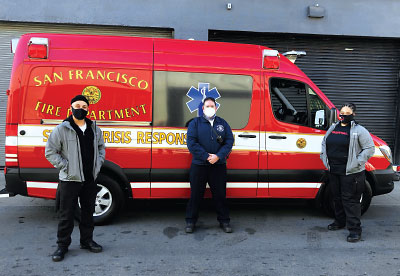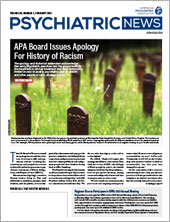When Walter Wallace Jr.’s family called the Philadelphia police last October for help dealing with another one of his “episodes,” they were hoping to get Wallace to a hospital. Relatives had placed several 911 calls that day about Wallace, who had been taking lithium for bipolar disorder. This time the 27-year-old father and aspiring rapper brandished a knife, and after a brief and chaotic encounter, police shot him dead.
At press time, Wallace’s death is one of the 1,384 fatal shootings by police in the past six years of people in a mental health crisis, according to a Washington Post database called “Fatal Force,” which includes information on fatal shootings by on-duty police officers since 2015. The Treatment Advocacy Center, a Virginia nonprofit focused on eliminating barriers to treatment for severe mental illness, says 1 in 4 fatal law enforcement encounters involves an individual with serious mental illness.
Late last year, San Francisco launched a pilot program to overhaul the city’s handling of nonviolent psychiatric crisis calls. Now, when a 911 or 311 call is placed in these types of cases, an unarmed Street Crisis Response Team will respond rather than police officers. The three-person team consists of a paramedic, a mental health professional, and a specially trained peer support counselor who is in recovery from mental illness, substance use, or homelessness.
The city receives about 17,000 calls a year involving people in a psychiatric or substance use crisis. Although they make up only a small proportion of calls to emergency services, they demand a significantly larger time investment from first responders, explained Sarah Owens, a spokesperson with the mayor’s office. The goal of the Street Crisis Response Team pilot is to divert nonviolent individuals away from the criminal justice system and emergency rooms and into behavioral health treatment instead.
“This new program can help us break the cycle that all too often keeps people going in and out of our emergency rooms or our jails,” San Francisco Mayor London N. Breed said in a statement announcing the pilot program. “When the Street Crisis Response Team responds to a call for someone in crisis, the team will be able to help with compassion and clinical skills to get people the care and support they need.”
San Francisco’s budget for the program is $18.5 million over two years, and the teams will include master’s- or doctoral-level mental health professionals, including psychologists and licensed therapists, Owens explained. The city launched the program with one team working in the high-needs Tenderloin neighborhood and hopes to have up to six teams working citywide by March.
In Eugene and Springfield, Ore., a similar program has been operating successfully on a smaller scale for more than 30 years. Known as Crisis Assistance Helping Out On The Streets (CAHOOTS), it now handles about 20% of calls dispatched by 911 (see
Psychiatric News). There, two-person teams—an unarmed medic and a mental health crisis worker—respond to all mental health crisis calls, such as those involving intoxication, welfare checks, suicide threats, and conflict resolution. Rather than carry weapons, the CAHOOTS teams rely on trauma-informed conflict de-escalation techniques.
CAHOOTS appears to be successful: Of the 24,000 calls fielded in 2019, the teams requested police backup only 150 times, according to a brochure provided by Arlo Silver, the CAHOOTS office manager. Similar programs modeled on CAHOOTS are now being established in Olympia, Wash.; Albuquerque, N.M.; Indianapolis, Ind.; Hartford, Conn.; Los Angeles; and New York City.
Operating on a $2.1 million annual budget, CAHOOTS lightens the load on the Eugene police department, saving taxpayers $8.5 million a year on public safety and $14 million in emergency room and ambulance costs, according to the brochure. About 30% of those helped each year there live with severe and persistent mental illness, and more than 60% are homeless.
Psychiatrists Endorse Approach
In San Francisco, the new teams will be able to perform assessments, do brief interventions that might negate the need for a hospital stay, or even transport patients to the city’s 24-hour mental health urgent care clinic.
“I’m excited about this new program. I think this is something that should have been done a long time ago,” said Tara C. Collins, M.D., M.P.H., an assistant clinical professor in the Department of Psychiatry and Behavioral Science at the University of California, San Francisco (UCSF). Police officers typically don’t have the specialized training needed for dealing with people in the throes of a mental health or substance use crisis, she said.
“It might be necessary to have police involvement in some cases, but police don’t need to be the first people on the scene,” she added. Unfortunately, the behavior of people with mental illness has been increasingly criminalized over the years, especially since more people with chronic and severe mental illness have been turned out of long-term institutions and onto the streets. Many cities including San Francisco have passed ordinances making it illegal to sit or lie on the sidewalk. Such laws result in more interactions—and clashes—between those in crisis and the police.
What remains to be seen is how dispatchers will determine whether a particular situation requires police presence, said Eric Chan, M.D., an assistant clinical professor of psychiatry at UCSF. “Many of these situations don’t require police. But if a situation escalates or a person suddenly produces a weapon, will these crisis teams be equipped to deal with it? Will they be able to safely help a person who might require restraints or medications in the field? That is a concern.”
Chan said he envisions the team approach as a complement to providing police officers with Crisis Intervention Team (CIT) training. “It doesn’t need to be an either-or approach,” he added. “The CIT-trained officers have a more calming approach and are better able to de-escalate situations without inflicting trauma.” ■
Information about the San Francisco pilot project is posted
here.
“Fatal Force,” the Washington Post database on fatal police shootings, is posted
here.

